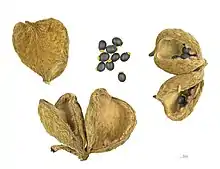| Sterculia setigera | |
|---|---|
 | |
| Nuts and seeds | |
| Scientific classification | |
| Kingdom: | Plantae |
| Clade: | Tracheophytes |
| Clade: | Angiosperms |
| Clade: | Eudicots |
| Clade: | Rosids |
| Order: | Malvales |
| Family: | Malvaceae |
| Genus: | Sterculia |
| Species: | S. setigera |
| Binomial name | |
| Sterculia setigera Delile | |
| Synonyms[2] | |
| |
Sterculia setigera is a deciduous tree species within the Malvaceae family. It commonly occurs in the Sahelo-Sudan and Guinea savannah zones of Tropical Africa. Among the Hausa people it is known as Kukkuki.[3] It is an important tree crop in Senegal as Gum karaya obtained from the woody species is exported from the country.[4][5]
Description
A deciduous tree that is capable of reaching 18 meters in height,[6] it has an open spreading crown with buttressed base, its grey purple bark peels off in thin, irregular scales[4] leaving pale patches, while a slash reveals a fibrous, brownish to red inner bark and a white exudate.
Leaves are simple and alternate in arrangement, nerves palmately arranged at base with leaves 5 entire or pointed lobes; leaf-blade is ovate to orbicular in outline, upper surface tends to be stellate and tomentose.
Inflorescence is raceme type, calyx, 5 lobed, up to 12 mm in diameter, outer surface is green while inner surface is purple-red. The flowering period begins towards the end of the dry season between the months of February and April.[4] Fruit is a sessile follicle, 6-10 cm long,[6] oblong in shape, grey-green or brown in color and many seeded, follicle can stay on tree even when seeds falls off.
Distribution
Occurs from Senegal eastwards to Sudan and Ethiopia and in Angola, found in the savanna ecological zones, frequently on hill or rocky soils and in shallow gritty soils.[4][6]
Chemistry
Tests on stem bark extracts of the plant isolated the chemical compound, lupeol and a class of Procyanidin trimers.[7] The sugar properties of the gum obtained from the species consisting of D-galacturonic acid, L-rhamnose, D-galactose[8] is quite similar to those obtained from Sterculia Urens.[9][10]
Uses
Seeds are eaten by nomadic groups in Northern Nigeria.[3] A wide spread species, it has multi-purpose functions in various local communities. A decoction of stem bark extracts are used as part of an herbal regimen to treat skin ailments and infections, fever, diarrhea and toothache.[7][11]
References
- ↑ IUCN SSC Global Tree Specialist Group; Botanic Gardens Conservation International (BGCI) (2020). "Sterculia setigera". IUCN Red List of Threatened Species. 2020: e.T156106803A156106805. doi:10.2305/IUCN.UK.2020-3.RLTS.T156106803A156106805.en. Retrieved 6 November 2021.
- ↑ "Sterculia setigera". Plants of the World Online. Royal Botanic Gardens, Kew. Retrieved 3 November 2021.
- 1 2 Ayodele, JT; Alao, OA; Olagbemiro, TO (20 January 2010). "The chemical composition of Sterculia setigera". Tropical Journal of Animal Science. 3 (2). doi:10.4314/tjas.v3i2.49771.
- 1 2 3 4 Atakpama, Wouyo; Batawila, Komlan; Dourma, Marra; Pereki, Hodabalo; Wala, Kpérkouma; Dimobe, Kangbéni; Akpagana, Koffi; Gbeassor, Messanvi (14 November 2012). "Ethnobotanical Knowledge of Sterculia setigera Del. in the Sudanian Zone of Togo (West Africa)". ISRN Botany. 2012: 1–8. doi:10.5402/2012/723157. S2CID 73141153.
- ↑ Tadesse, Wubalem; Desalegn, Getachew (2009). "Sterculia setigera del. potential dryland resource for the production of gum karaya in Ethiopia: review" (PDF). Ethiopian Journal of Natural Resources. 11 (1): 83–98. S2CID 21715613.
- 1 2 3 Arbonnier, Michel (2004). Trees, shrubs, and lianas of West African dry zones. CIRAD ; Margraf ; Muséum national d'histoire naturelle. ISBN 978-2-87614-579-5. OCLC 56937881.
- 1 2 Alshambaty, Khansa; Yagi, Sakina; Elbashir, Abdalla A.; Schohn, Hervé; Tzanova, Tzvetomira; Mohammed, Ibrahim; Ak, Gunes; Mahomoodally, Mohamad Fawzi; Stefanucci, Azzurra; Mollica, Adriano; Zengin, Gökhan (November 2020). "Chemical constituents and biological activities of African medicinal tree Sterculia setigera Delile stem bark". South African Journal of Botany. 143: 274–281. doi:10.1016/j.sajb.2020.10.008. S2CID 228958510.
- ↑ Hough, L.; Jones, J. K. N. (1950). "247. The structure of Sterculia setigera gum. Part II. An investigation by the method of paper partition chromatography of the products of hydrolysis of the methylated gum". Journal of the Chemical Society (Resumed): 1199. doi:10.1039/jr9500001199.
- ↑ Aspinall, G. O.; Fraser, R. N.; Sanderson, G. R. (1965). "798. Plant gums of the genus Sterculia. Part III. Sterculia setigera and Cochlospermum gossypium gums". Journal of the Chemical Society (Resumed): 4325. doi:10.1039/jr9650004325.
- ↑ Anderson, D. M. W.; McNAB, C. G. A.; Anderson, C. G.; Brown, P. M.; Pringuer, M. A. (January 1983). "Studies of uronic acid materials, Part 58: Gum exudates from the genus Sterculia (gum karaya)". International Tree Crops Journal. 2 (2): 147–154. doi:10.1080/01435698.1983.9752749.
- ↑ Zaruwa, Moses Z.; Ibok, Nne. I.; Ibok, Ibokabasi U.; Onyenonachi, Emmanuel C.; Danchal, C.; Ahmed, Aisha G.; Ahmed, Maryam U.; Sudi, Ismaila Y. (January 2016). "Effects of Sterculia setigera Del. Stem Bark Extract on Hematological and Biochemical Parameters of Wistar Rats". Biochemistry Insights. 9: 19–22. doi:10.4137/BCI.S36143. PMC 5153318. PMID 27980418.
